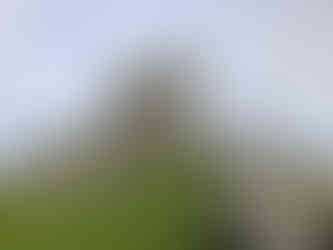Dunnideer Hill Fort
- Lilly

- May 14, 2019
- 3 min read

As I mentioned in yesterday's post, after my overnight on Bennachie, I couldn't resist popping over to Hill of Dunnideer to check out the ruin and remnants of the vitrified hillfort on top. I could see it from Bennachie, tempting me. So after returning to the car in the morning, my tired legs wrestled with my curiosity and you can see which side won 😉 Its only about a 10 minute drive from the Back O Bennachie car park, and there is a nice little lay-by for parking.
The hill is covered with blooming gorse, so the walk up was heavenly on the eyes and the nose - gorse smells very similar to coconut! The walk isn't a long one but it is a steep one. Dunnideer may once have been a mighty stronghold but these days, it belongs to the rabbits. Their burrows are everywhere, creating a big warren through the hill - poor Luna was on heightened alert!
This castle is believed to be the earliest tower house on the Scottish mainland. Historic Scotland says it was "traditionally built by Gregory the Great in AD 890, but more likely by David, Earl of Huntingdon and Garioch in 1178." The first written reference to it is in 1260 as the "stronghold of Sir John de Balliol." I've read that its believed this may have been the father of THE John Balliol, King of Scotland and opponent of Robert the Bruce. I've read speculation that the castle may have been destroyed during the Wars of Independence by Robert the Bruce after seizing it from the Balliols for opposing him. But none of this is known for sure.
As is common in historic structures, the builders reused the remains of the vitrified fort that had been on the hill for centuries prior to them. A vitrified fort means it was subjected to heat strong enough to melt the stones together. This would need to be about 1000C/1800F! How this kind of heat was achieved (and why) has been speculated plenty but is still a mystery. It is really difficult to date the hillfort but it could be as far back as 1000BC. Luna didn't wait for me to ask her to pose, I was taking a shot of the melted stone up close and there she was striking a pose o top of the vitrified fragment. Nailed it Luna, nailed it 😉
I could have continued on down the other side of the hill and across the fields to the remains of a recumbent circle in the trees, but I left it for another time. It was time to go home and take a nap!
From the top of Dunnideer I could see back over to Bennachie, which has a hill fort on Mither Tap, and to Tap O Noth in the other direction, which also has a vitrified fort. To some it might seem that going around and checking things off a list so to speak, isn't a very good technique for researching. But what its doing is giving me a feel for the lay of the land, for where things were placed, and their relationship with one another. Sure I can read about this in a book or see it in points on a map, but forming the picture on the ground, in my own mind, has really done a lot. I can envision what its like to look toward Dunnideer from Tap O Noth, what Tap O Noth looks like from the Craw Stane, what Mither Tap looks like from a scarcely documented medieval stone I hunted down in the woods (that will be for another blog!), and so on. And I now know what is like to sleep on Mither Tap, what the birds sound like when they're waking up atop the hills, how the moonlight plays on the walls of the fort. Its also important to visit things that were erected long before the Picts - because they most certainly would have had curiosity and reverence for things like standing stones, recumbent stone circles, hill forts, etc that were in place long before them. All of these visits to various places have begun to piece together an understanding and an invaluable perspective as I attempt to tell a story of the people who called these places home.













Comments